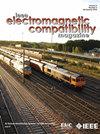Accurate Measurement of Intradecoupling Characteristics for Noise Suppression Sheets on Conducting Plates in Low-Frequency Range
IF 2.5
3区 计算机科学
Q3 ENGINEERING, ELECTRICAL & ELECTRONIC
IEEE Transactions on Electromagnetic Compatibility
Pub Date : 2025-02-26
DOI:10.1109/TEMC.2025.3538563
引用次数: 0
Abstract
In this article, a test method is proposed for accurately evaluating the intradecoupling characteristics of noise suppression sheets (NSSs) on a conducting plate using two loop probes placed perpendicularly to the NSS on the same side. The effectiveness of the proposed method is discussed in comparison with the standard test method from IEC 62333-2, particularly by examining the underlying mechanisms based on the image method. To establish a test setup for measuring intradecoupling at frequencies below 100 MHz, the effects of various factors including the distance between the two loop probes, the distance from the probes to the NSS, and the size of the NSS were investigated using three-dimensional full-wave numerical simulations and design of experiments. For validation, intradecoupling ratios of commercial NSSs were measured using both the IEC 62333-2 method and the proposed method with two rectangular loop probes. In addition, regression analysis based on the measurement results was used to derive linear equations for predicting the intradecoupling ratio based on the real relative permeability and thickness, within the frequency range where real permeability is constant. The intradecoupling ratios at 1 MHz predicted by these regression equations showed an average deviation of 0.36精确测量低频范围内导电板上噪声抑制片的内耦合特性
本文提出了一种准确评估导电板上噪声抑制片(NSS)内耦特性的测试方法,该方法使用垂直于NSS同侧的两个环路探头。通过与IEC 62333-2标准测试方法的比较,讨论了所提出方法的有效性,特别是通过检查基于图像方法的底层机制。为了建立100 MHz以下频率下测量内耦的测试装置,利用三维全波数值模拟和实验设计,研究了两个环探针之间的距离、探针到NSS的距离以及NSS的大小等因素对内耦测量的影响。为了验证,使用IEC 62333-2方法和使用两个矩形环路探针的方法测量了商用nss的内耦比。此外,根据实测结果进行回归分析,推导出在真实渗透率恒定的频率范围内,基于真实相对渗透率和厚度的内耦比预测的线性方程。由回归方程预测的1 MHz下的内耦比与导电板上实际nss的测量值的平均偏差为0.36美元。
本文章由计算机程序翻译,如有差异,请以英文原文为准。
求助全文
约1分钟内获得全文
求助全文
来源期刊
CiteScore
4.80
自引率
19.00%
发文量
235
审稿时长
2.3 months
期刊介绍:
IEEE Transactions on Electromagnetic Compatibility publishes original and significant contributions related to all disciplines of electromagnetic compatibility (EMC) and relevant methods to predict, assess and prevent electromagnetic interference (EMI) and increase device/product immunity. The scope of the publication includes, but is not limited to Electromagnetic Environments; Interference Control; EMC and EMI Modeling; High Power Electromagnetics; EMC Standards, Methods of EMC Measurements; Computational Electromagnetics and Signal and Power Integrity, as applied or directly related to Electromagnetic Compatibility problems; Transmission Lines; Electrostatic Discharge and Lightning Effects; EMC in Wireless and Optical Technologies; EMC in Printed Circuit Board and System Design.

 求助内容:
求助内容: 应助结果提醒方式:
应助结果提醒方式:


